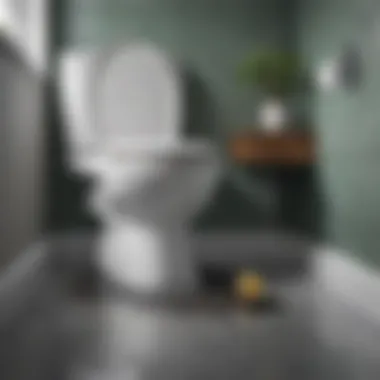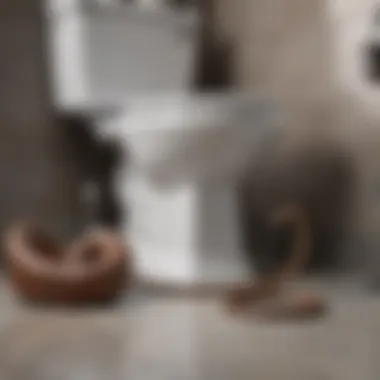Unclog Your Toilet: 10 Effective Methods Without a Plunger


Intro
Encountering a clogged toilet can be a frustrating situation for anyone. Many people instinctively reach for a plunger, but there are effective techniques that do not require this tool. Understanding these methods can save you time and hassle.
In this article, we will explore several liquid solutions, natural remedies, and practical mechanical methods to clear a clogged toilet. We will examine common causes of toilet clogs and provide you with actionable tips to prevent future blockages. Homeowners and individuals seeking quick solutions will find valuable information to help manage plumbing issues effectively.
Common Causes of Toilet Clogs
Before delving into the solutions, it is essential to understand what typically causes toilet clogs. These clogs can arise from a variety of factors:
- Excessive toilet paper: Using too much toilet paper can overwhelm the plumbing system.
- Foreign objects: Items like toys, sanitary products, or other non-flushable materials can obstruct pipes.
- Old plumbing: Aging pipes may become narrow or corroded, leading to frequent clogs.
- Flushing inappropriate materials: Only toilet-related waste should be flushed.
By recognizing these causes, you can take preventative measures and employ strategies to unclog toilets without plunging.
Liquid Solutions
One of the quickest ways to address a clogged toilet is by using liquid solutions. Here are a few effective options:
- Hot Water: Pouring hot water into the toilet bowl can help dissolve potential blockages. Boil water in a kettle, and then carefully pour it from waist height. This helps create pressure that may dislodge the clog.
- Dish Soap: Adding a generous amount of dish soap can lubricate and break down the build-up. Allow it to sit for at least 15 minutes before adding hot water.
- Baking Soda and Vinegar: This combination can create an effective reaction. Pour one cup of baking soda followed by one cup of vinegar into the toilet. Let it fizz for 30 minutes, then flush with hot water.
Natural Remedies
For those who prefer natural solutions, several remedies can be effective:
- Epsom Salt: This can help soften the clog. Pour a cup of Epsom salt into the bowl, let it dissolve, then flush.
- Essential Oils: Certain essential oils like tea tree or lavender can help combat odors and may have some unclogging properties. Add a few drops and let it sit for a while.
Mechanical Techniques
If liquid solutions are not helpful, consider mechanical techniques:
- Toilet Auger: This tool can navigate deeper into the plumbing and can break up stubborn clogs. Insert the auger into the bowl and crank the handle to break apart the material causing the blockage.
- Wet/Dry Vacuum: If available, a wet/dry vacuum can be useful. Create a seal around the toilet to draw the clog up and out. Make sure to follow safety precautions, and check that none of the vacuum’s internal mechanisms will be damaged by wet materials.
Preventive Measures
To avoid future clogs, consider these preventative measures:
- Use less toilet paper and encourage household members to do the same.
- Educate everyone about what can and cannot be flushed.
- Regularly maintain plumbing systems, inspecting for any signs of wear or damage.
Implementing these strategies will not only help in dealing with immediate issues but will also assist in maintaining clear pipes long-term.
"By understanding the causes and effective solutions for toilet clogs, you empower yourself to handle plumbing problems confidently."
Understanding Toilet Clogs


Comprehending the nature of toilet clogs is essential for effective management and resolution. Toilets are prone to clogs due to various factors. Recognizing these factors can save time and prevent damage. By understanding clogs, you can tackle the problem with confidence and clarity.
Common Causes of Toilet Clogs
Several elements contribute to toilet clogs. Common causes include:
- Excessive toilet paper: Many people underestimate the impact of using larger amounts of toilet paper. Even if the toilet is rated for low flow, overuse can lead to blockages.
- Foreign objects: Items such as wipes, cotton balls, or personal hygiene products often find their way into toilets. These items do not dissolve and can easily cause clogs.
- Flushing improper items: It's important to educate everyone in the household about what should not be flushed. Wrong items block pipes.
- Natural wear: Over time, pipes can corrode or become blocked with mineral deposits. This can reduce flow and lead to clogs.
Signs of a Clogged Toilet
Identifying a clog early is critical for avoiding more serious plumbing issues. Common signs of a clogged toilet are:
- Slow draining: If water drains slowly, it often indicates that there is a blockage.
- Water level fluctuations: High or low water levels in the bowl may also signify a clog.
- Unusual noises: Gurgling or bubbling sounds can indicate that air is trapped in the plumbing system due to a clog.
- Multiple fixtures backing up: If other drains in your home are also slow, the issue could be more serious than a single toilet.
Importance of Addressing Clogs Promptly
Ignoring a clogged toilet can lead to severe consequences. It is crucial to address clogs without delay because:
- Water damage: Clogs can lead to overflow, causing damage to floors and walls. This can result in costly repairs.
- Unpleasant odors: Stagnant water breeds bacteria and can create foul smells that permeate the home.
- Increased repair costs: The longer you wait, the worse the clog can become. Early action may prevent needing a plumber's assistance.
To protect your home, recognize the signs of clogs and act quickly before issues escalate.
Liquid Solutions for Unclogging
Liquid solutions play a crucial role in the process of unclogging a toilet without a plunger. The beauty of these techniques lies in their simplicity and accessibility. Many households already have these ingredients, making the methods both economical and practical. Moreover, these solutions often feature common household items that are safe for both users and the plumbing system. By employing liquid solutions, individuals can often resolve minor clogs effectively, reducing the need for excessive mechanical intervention, which can sometimes lead to further plumbing complications.
Hot Water Technique
The hot water technique is one of the simplest yet effective methods for unclogging a toilet. It involves pouring hot water into the bowl from waist height. This process can help dissolve the matter causing the blockage. However, it’s essential to be cautious. Very hot water should be avoided, as it may crack the porcelain of the toilet.
- Boil a kettle of water or use a large pot on the stove.
- Allow the water to cool slightly for a minute or so to prevent damage to the toilet.
- Pour the water steadily into the toilet bowl from a height of about two feet.
- Wait a few minutes to see if the clog begins to dissipate. If needed, repeat the process.
This technique is especially effective for minor blockages, including toilet paper buildup or other soft materials that can dissolve in heat.
Dish Soap Method
The dish soap method is particularly effective for clogs caused by organic matter or other blockable substances. Dish soap acts as a lubricant, breaking down grease and helping to ease the flow through the plumbing.
- Apply a generous amount of dish soap directly into the toilet bowl.
- Let it sit for about 10-15 minutes. This waiting period allows the soap to seep down and loosen the clog.
- Follow it with hot water, applied cautiously as mentioned in the previous section.
- Wait for the clog to clear. You can flush after a few minutes to check the results.
This method is effective because the soap helps to coat the pipes and facilitates the removal of obstructions.
Baking Soda and Vinegar Reaction
The reaction between baking soda and vinegar can create a powerful natural solution for unclogging toilets. This method combines the fizzing action of vinegar with the expanding properties of baking soda, potentially dislodging tough clogs with its bubbling energy.


- Pour one cup of baking soda into the toilet bowl.
- Follow with one cup of vinegar. The fizzing will commence instantly.
- Let it sit for around 30 minutes. It’s wise to close the toilet lid to contain the fizz.
- Flush the toilet. If the clog persists, repeating the process may yield better results.
The combination provides a thorough clean and can often dissolve both minor and moderate clogs without the need for harsh chemicals.
"Using household remedies like dish soap and baking soda can be effective first line responses for toilet clogs, offering a blend of efficiency and safety for your plumbing system."
With these liquid solutions, homeowners can tackle clogs promptly and efficiently, which is vital in maintaining the overall health of their plumbing systems. Regularly implementing these methods can help avoid future clogs and ensure that toilets function efficiently.
Mechanical Techniques for Clearing Clogs
Mechanical techniques can be invaluable when dealing with a clogged toilet. These methods are essential as they offer a direct approach to resolving the blockage without relying on potentially ineffective liquid solutions. Moreover, these techniques often provide immediate relief, especially for stubborn clogs. Choosing the right method depends on the severity of the clog and the tools available at one's disposal.
Manual intervention, in general, allows for more control over the process. However, it is important to consider the types of clogs, as some issues may require different approaches. Here are three effective mechanical techniques to clear clogs that you can use.
Using a Toilet Auger
A toilet auger, also known as a closet auger, is a specialized tool designed to clear toilet clogs. Its long, flexible metal shaft can navigate the curves of toilet plumbing. To use a toilet auger, follow these steps:
- Insert the auger: Feed the end of the auger into the toilet bowl. Be careful not to scratch the porcelain.
- Crank the handle: Turn the handle on the auger to extend the snake deeper into the toilet trap. You may encounter resistance as it reaches the clog.
- Push and pull: Rotate the auger in a circular motion to break apart the clog. If it gets stuck, pull it back slightly and adjust your angle.
- Remove the auger: Once you feel the clog has been cleared, gently pull the auger out of the toilet.
- Flush the toilet: Conduct a flush to ensure that the clog has been completely removed.
Using a toilet auger can effectively dislodge material that may be closer to the trap.
Wet/Dry Vacuum Approach
A wet/dry vacuum is another useful tool for clearing toilet clogs. This approach can be effective if employed correctly.
- Prepare the vacuum: Make sure the vacuum is set up for wet use and connected to a power source. It must also have a clean container ready to collect debris and waste.
- Create a seal: Position the vacuum hose over the toilet drain. You may need to create a seal using a towel or rag to enhance suction.
- Turn on the vacuum: Power the vacuum on and let it work. This will create a strong suction to pull out the clog.
- Check the results: After a minute or two of vacuuming, turn it off and check for improvement. Repeat if needed until the clog is cleared.
- Clean the area: After clearing the clog, ensure to clean the vacuum container and the surrounding area to avoid any mess.
This method is particularly useful for clogs caused by solid objects or excessive items lodged in the toilet.
Creating Suction with a Hose
In situations where a plunger is unavailable, using a hose to create suction can also be an effective measure.
- Get a long hose: Ensure it is strong enough to withstand pressure. The hose should ideally be the same diameter as your toilet's drain.
- Insert the hose: Place one end of the hose into the toilet drain. Make sure it fits snugly within the drain opening.
- Create suction: Cover the other end of the hose with your hand or a rag. This should help maintain the suction needed for better clogs removal.
- Pull and release: Quickly pull the hose back while removing your hand from the opening. The sudden change in air pressure can help dislodge the clog.
- Repeat if necessary: You may need to do this several times to clear more stubborn clogs.
This technique requires a bit of finesse and may take several attempts for effective results.
Important note: Always ensure you have proper safety measures in place when performing any of these techniques to avoid injury or further plumbing issues.
Mechanical methods, while they can take more effort, offer a reliable way to tackle clogs without traditional plungers. Opting for these methods can save time and prevent potential damage to plumbing.
Preventive Maintenance for Toilets
Preventive maintenance for toilets is essential in avoiding plumbing disasters. Understanding proper upkeep can save homeowners both time and money. Regular maintenance helps identify potential issues before they escalate, providing peace of mind. There are several specific elements to consider and incorporate in a maintenance routine which can diminish the risk of future clogs and ensure your toilet functions correctly.


Regular Cleaning Practices
Regular cleaning is a cornerstone of preventive maintenance. Keeping your toilet clean not only promotes hygiene but also helps in identifying early signs of blockages. Use a toilet bowl cleaner and a scrub brush to remove stains and build-up. Additionally, it is advisable to clean under the rim to prevent slowing drainage.
- Frequency: Aim for at least once a week, more often in high-use households.
- Cleaning agents: Consider eco-friendly products to minimize environmental impact. Baking soda and vinegar can also be effective and less abrasive.
- Inspection during cleaning: While cleaning, take a moment to look at the flow of water. If it seems irregular, it might indicate a developing issue.
Proper Disposal Habits
What you flush down the toilet significantly affects its functioning. Many homeowners are unaware that various materials do not break down easily.
- Avoid flushing: Items like wipes, cotton swabs, and feminine hygiene products can easily cause blockages.
- Using the trash: Encourage all household members to dispose of non-flushable items in the trash rather than the toilet.
- Education: Teach children what is appropriate to flush, helping foster responsible habits early on.
A few commonsense measures in this area can prevent significant future troubles.
Toilet Paper Alternatives and Usage
The type and amount of toilet paper used can contribute to clogging. Some alternatives or approaches may help manage waste more effectively.
- Choose thin paper: Brands that are designed to dissolve quickly can reduce the likelihood of clogs.
- Limit usage: Educate users to use only the necessary amount. Excessive paper will increase the chances of clogging.
- Consider alternatives: In some cases, using a bidet or similar device can reduce dependency on toilet paper altogether.
Good maintenance practices can enhance the longevity of your toilet while significantly reducing the severity of any potential clogs. Always remain attentive to unusual signs that may require further investigation.
Regular upkeep will always win over reactive measures when it comes to toilet functionality.
Additional Tips and Considerations
Understanding when and how to address a clogged toilet is critical in maintaining both functionality and hygiene in your home. The strategies mentioned before provide immediate solutions, but there are several additional suggestions to consider that can enhance effectiveness in dealing with plumbing issues. The focus should be on how to recognize problematic situations, when to seek assistance, and how to adapt your approach for various unique scenarios. Being prepared with this knowledge may save time and money in the long run.
When to Call a Professional
Not all clogs can be resolved with home remedies or mechanical tricks. If the situation persists despite your best efforts, it may be time to call in a professional plumber. This decision should be determined by the duration of the clog, the associated symptoms, and if multiple toilets or drains are affected. Signs that suggest the need for professional help include:
- Persistent Blockages: If the toilet remains clogged after multiple attempts at clearing it.
- Multiple Drain Issues: When other sinks or drains in your home are also slow or completely blocked.
- Water Backflow: If water starts to back up into other fixtures or visibly leaks.
- Unusual Noises: Sounds such as gurgling can indicate bigger issues within your plumbing system.
Calling a professional ensures that the problem gets diagnosed correctly. Plumbers have the tools and expertise to handle deep blockages and underlying plumbing issues right away.
Assessing the Severity of the Clog
Before attempting to clear a clog, it can be beneficial to assess its severity. This evaluation can inform your strategy moving forward. A simple method includes:
- Observation: Does the toilet empty gradually or remain completely full?
- Odor Check: Is there an unpleasant smell indicating a deeper blockage?
- Water Levels: Check if the water level fluctuates; high levels can mean significant blockages.
- Attempt a Flush: A cautious flush may reveal how much obstruction exists. If it backs up, the clog is likely severe.
This assessment helps in deciding whether to initiate common techniques or consult a plumber directly.
Alternative Methods for Unique Situations
In unique circumstances where standard techniques do not apply, consider alternative approaches:
- Pumping with a Toilet Auger: If a simple auger does not work, a powered auger might break through more stubborn clogs.
- Enzyme Drain Cleaners: These are ideal for soft clogs, especially those caused by biological matter. They work over time without harsh chemicals.
- Salt and Hot Water: Salt can work wonders as a solvent combined with hot water. Pour it in and allow it to sit before trying to flush again.
Overall, knowing these alternatives ensures preparedness for unexpected clogging scenarios, maximizing your toilet's performance while minimizing damage.















